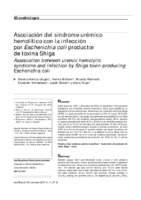Please use this identifier to cite or link to this item:
http://sgc.anlis.gob.ar/handle/123456789/145| Title: | Asociación del síndrome urémico hemolítico con la infección por Escherichia coli productor de toxina Shiga | Other Titles: | Association between uremic hemolytic syndrome and infection by Shiga toxin-producing Escherichia coli | Authors: | Giugno, S. M. Bibiloni, N. Rahman, R. Miliwebsky, Elizabeth Chinen, Isabel Rivas, Marta |
Keywords: | Síndrome Hemolítico-Urémico;Escherichia coli;Toxina Shiga;Niño | Issue Date: | 2007 | Description: | Entre enero de 1997 y diciembre de 2002 se estudiaron 208 pacientes pediátricos con síndrome urémico hemolítico (SUH) para establecer su asociación con la infección por Escherichia coli productor de toxina Shiga (STEC). La edad promedio de los pacientes fue 22±19 meses. El 53,8% fue de sexo femenino. Los casos se presentaron principalmente en niños eutróficos (85,1%), de condición socioeconómica media (52%), durante el verano y principio del otoño (87%). El 95,5% de los niños presentó diarrea, que en el 74,2% de los casos fue sanguinolenta. El 44% de los pacientes recibió antibioticoterapia durante el período prodrómico. Se aisló STEC en 9,8% de los casos. El serotipo aislado con mayor frecuencia fue Escherichia coli O157:H7 (83,3%) y se detectó la toxina Shiga libre en materia fecal (StxMF) en el 21% de las muestras estudiadas. Se encontraron evidencias acumulativas de infección por STEC en 59,1% de los pacientes. Between January 1997 and December 2002, a total of 208 pediatric patients with hemolytic uremic syndrome (HUS) were studied to establish its association with Shiga toxin-producing Escherichia coli (STEC) infection. The median age was 22±19 months, and 53.8% were female patients. Cases were mainly well nourished children (85.1%) from a middle class condition (52%); 95.5% had diarrhea, (bloody diarrhea in 74.2%), during the summer and at the beginning of autumn (75%). Forty-four per cent received antibiotic therapy during the prodromic period. STEC was isolated in 9.8% of the cases, being Escherichia coli O157:H7 the most frequent serotype isolated (83.3%). Shiga free toxin was detected in stools (StxMF) in 21% of the samples studied. Cumulative evidences of infection by STEC were found in 59.1% of the patients. Fil: Giugno, S. M. Hospital I.A.E.P. Superiora Sor María Ludovica. Laboratorio Central; Argentina. Fil: Bibiloni, N. Hospital I.A.E.P Superiora Sor María Ludovica. Servicio de Nefrología; Argentina. Fil: Rahman, R. Hospital I.A.E.P Superiora Sor María Ludovica. Servicio de Nefrología; Argentina. Fil: Miliwebsky, Elizabeth. ANLIS Dr.C.G.Malbrán. Instituto Nacional de Enfermedades Infecciosas. Servicio de Fisiopatogenia; Argentina. Fil: Chinen, Isabel. ANLIS Dr.C.G.Malbrán. Instituto Nacional de Enfermedades Infecciosas. Servicio de Fisiopatogenia; Argentina. Fil: Rivas, M. ANLIS Dr.C.G.Malbrán. Instituto Nacional de Enfermedades Infecciosas. Servicio de Fisiopatogenia; Argentina. |
URI: | http://sgc.anlis.gob.ar/handle/123456789/145 http://www.scielo.org.ar/pdf/abcl/v41n1/v41n1a04.pdf |
ISSN: | 1851-6114 | Rights: | info:eu-repo/semantics/openAccess |
| Appears in Collections: | snrd Publicaciones INEI |
Files in This Item:
| File | Description | Size | Format | |
|---|---|---|---|---|
| ActaBioquímicaClínicaLatinoamericana,2007,41(1),27–33..pdf | 42.42 kB | Adobe PDF |  View/Open |
Page view(s)
168
checked on Dec 23, 2025
Download(s)
38
checked on Dec 23, 2025
Google ScholarTM
Check
Items in DSpace are protected by copyright, with all rights reserved, unless otherwise indicated.

